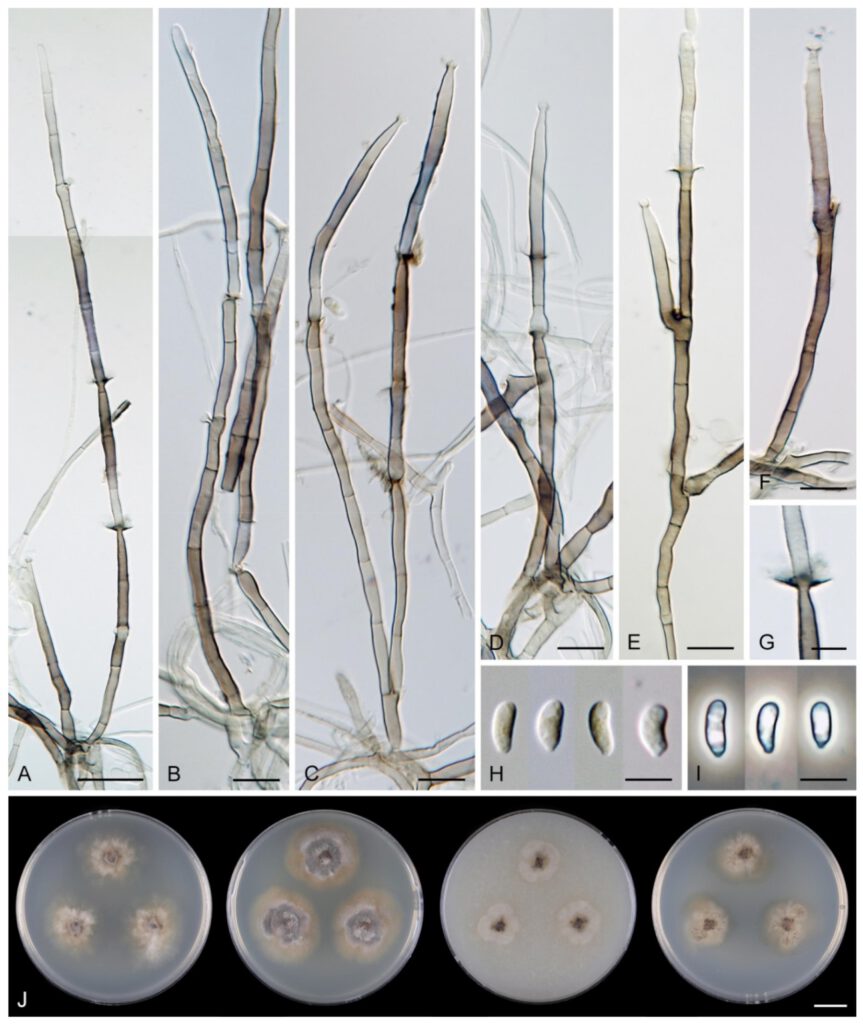Flectospora laminata Réblová & Hern.-Restr., sp. nov.
MycoBank number: MB 839479; Index Fungorum number: IF 839479; Facesoffungi number: FoF14549.
Etymology: Lamina (L), plate, -ata (L) possessing, referring to the saucer-shaped collarettes that remain on the conidiophore after the phialide extends percurrently.
Type: THAILAND, Nakhon Nayok Province, Khao Yai National Park, Bung Phai trail ca. 5 km NW from Khao Yai forest Headquarters on a way to Pak Chong, alt. 750 m, 14°28’N 10°23’E, on decaying wood, 6 September 2001, M. Réblová, G. J. Samuels & R. Nasit M.R. 2220/TH 511 (holotype PRA-19895 as dried culture, voucher PRM 900543 holotype of Chaetosphaeria hispida, culture ex-type CBS 112964 = DAOM 231140).
Description on the natural substrate: Colonies effuse, hairy. Anamorph: Setae absent. Conidiophores 46–82 m long, (3–)3.5–4 m wide near the base, macronematous, mononematous, solitary, erect, straight or slightly flexuous, cylindrical, unbranched, thick-walled, brown, paler upwards, 4–6-septate, darker brown at the septa. Conidiogenous cells 15–35 × 3–4 m, tapering to ca. 1.5 m below the collarette, integrated, terminal, mono- or polyphialidic with 2–5 lateral apertures arising from the sympodial proliferation; collarettes 2.5–3 m wide, 2–2.5(–3) m deep, funnel-shaped, hyaline. Conidia (4.5–)5–6 × 2.5–3 m (mean ± SD = 5.5 ± 0.3 × 2.6 ± 0.1 m), ellipsoidal to obovoidal, slightly curved, truncate at the base, rounded apically, aseptate, hyaline, smooth. (adapted from Réblová and Seifert [19]). Teleomorph: not observed.
Characteristics in culture: On CMD colonies 20–22 mm diameter, circular, flat, mar-gin rhizoidal, lanose, funiculose centrally, white-beige, with a pale ochre outer zone of submerged growth, reverse dark beige. On MLA colonies 22–27 mm diameter, circular, raised, margin entire, lanose, floccose, cobwebby towards the periphery, whitish to mouse grey with an ochre outer zone of submerged growth, pale ochre pigment diffusing into agar, reverse ochre. On OA colonies 12–13 mm diameter, circular, flat, margin entire to weakly undulate, cobwebby, white to ochre-beige with irregular dark grey spots due to aggregated sporulating conidiophores, with an olivaceous ochre outer zone of submerged growth, reverse pale ochre-beige. On PCA colonies 17–20 mm diameter, circular, circular, flat, margin entire, lanose to cobwebby, ochre-beige an olivaceous ochre outer zone of submerged growth, reverse of the same colours. Sporulation was abundant on MLA and PCA, sparse on CMD and OA.
Colonies on PCA effuse, hairy, mycelium composed of branched, septate, hyaline to pale brown hyphae 1–2 m diam. Anamorph: Setae absent. Conidiophores 46–220 m long, 2.5–3.5 m wide above the base, macronematous, unbranched, occasionally branched in the lower part with 1–2 lateral branches, erect, straight or flexuous, septate, smooth, brown, pale brown to subhyaline towards the apex. Conidiogenous cells 13.5–33.5 × 3–4 m, taper-ing to 1.5–2 m below the collarette, integrated, terminal, mono- rarely polyphialidic with one lateral aperture, extending percurrently and sympodially, cylindrical, pale brown to subhyaline, paler towards the apex; collarettes at the tip of the conidiogenous cells 2.5–4 m wide, 1.5–2.5 m deep, funnel-shaped, subhyaline, intercalary collarettes that are remain on the conidiophore after the conidiogenous cell extend percurrently are saucer-shaped, usually dark brown and appear like widely open flaps surrounding the conidiophore, 8–8.5 m wide, 1.5–2.5 m deep. Conidia 5–6.5 × 2–3 m (mean ± SD = 5.9 ±0.4 × 2.4 ± 0.4 m), ellipsoidal to obovoid, slightly curved, rounded at the apical end, tapering towards the base, base slightly truncate with a basal scar, hyaline, aseptate, smooth, conidia accumulate in slimy colourless fascicles. Teleomorph: not observed.
Habitat and geographical distribution: Saprobe on decaying wood, known only in Thailand.
Note: Although the conidiophores are unbranched on material from nature, they occasionally branch in the lower part when grown in the culture. The phialidic conidiogenous cells extend percurrently and form characteristic saucer-shaped collarettes that are persistent and appear like wide-open flaps, compared to the apical collarettes, which are subhyaline and funnel-shaped. Flectospora laminata resembles two Chloridium species. Chloridium curviellipticum was described from a decaying petiole of palm in Peru and differs in longer conidia, 6.5–11 × 2–2.5(–3) m [65]. Chloridium reniforme var. minor is known from Cuba on decaying wood and has shorter conidia, 3–4 × 1.2–1.8 m [73].

Figure 6. Flectospora laminata. (CBS 112964 ex-type). (A–F) conidiophores (G) saucer-shaped collarette (H,I) conidia (J) colonies on CMD, MLA, OA and PCA after 4 weeks (from left to right). Images: (A–I) on PCA after 4–6 weeks. Scale bars: (A) 20 m; (B–F) 10 m; (G–I) 5 m; (J) 1 cm.
